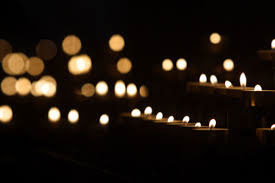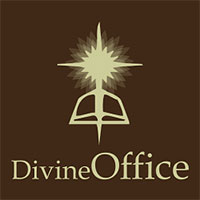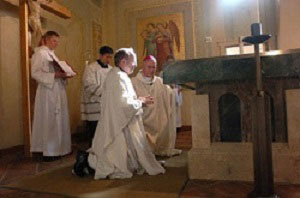Extended Vigil of the
Office of Readings
by the USCCB Committee on Divine Worship
This article is reprinted from the July 2018 issue of the NewsLetter of the Committee on Divine Worship.
Reprinted with authorization from Mary Elizabeth Sperry, USCCB Permissions Office.
"Stay awake!
For you do not know on which day your Lord will come" [Mt 24:42; cf. Mk 12:32-37, Lk 12:40].
Both Scripture and the teaching of the Church stress the importance of being ready for the coming of the Lord, whether in one's personl life at the hour of death, or in the world at lareg.
Saint Paul also counsels the Church in Thessalonica: "Pray without ceasing" [I Thess 5:17].
These words of advice are heeded by the Church in its liturgy, especially in the Liturgy of the Hours.
 The first hour of each day has long been celebrated at night, called Matins in the Extraordinary Form, or the Office of Readings since the Second Vatican Council.
To facilitate the praying of the Office of Readings for those clergy and faithful engaged in the apostolate, the Council directed that it be "adapted so that it may be recited at any hour of the day; it shall be made up of fewer psalms and longer readings" [Sacrosanctum concilium, n.89c].
Its nocturnal origins, however, are reflected in some of the ways this hour may still be prayed,
The first hour of each day has long been celebrated at night, called Matins in the Extraordinary Form, or the Office of Readings since the Second Vatican Council.
To facilitate the praying of the Office of Readings for those clergy and faithful engaged in the apostolate, the Council directed that it be "adapted so that it may be recited at any hour of the day; it shall be made up of fewer psalms and longer readings" [Sacrosanctum concilium, n.89c].
Its nocturnal origins, however, are reflected in some of the ways this hour may still be prayed,
Great honor has also been paid to the celebration of the longer, more solemn vigils [i.e. extended vigils] on the nights before great feasts, such as Christmas, Easter, and Pentecost.
The Easter Vigil, in particular, is the "mother of all Vigils," in which the faithful recall the saving power of God throughout the span of history [Roman Missal, Easter Vigil, no.20; cf. Saint Augustine, Sermon 219].
In fact, the Office of Readings on that night is simply a shortened form of the Liturgy of the Word from that Mass and is prayed only by those who do not attend the Easter Vigil Mass itself.
The General Instruction of the Liturgy of the Hours [GILH] provides context for the celebration of vigils: "As with the Easter Vigil, it was customary to begin certain Solemnities (different in different Churches) with a vigil.
Among these Solemnities Christmas and Pentecost are pre-eminent.
This custom should be maintained and fostered, according to the particular usage of each Church.
Whenever it seems good to add a vigil for other Solemnities or pilgrimages, the general norms for celebration of the word should be followed" [no.71].
Although vigils from the Divine Office are perhaps more likely to be celebrated by contemplative communities in monasteries and convents, the average parish can also make use of them to begin the celebration of a great solemnity or other diocesan feast, strengthen devotion to its patron saint, or foster a deeper spirit of prayer and community among parishioners.
The GILH specifes the format of vigils:
First, the Office of Readings is to be celebrated as in The Liturgy of the Hours up to the end of the readings.
After the two readings and before the Te Deum, canticles should be added from the special appendix of The Liturgy of the Hours.
Then the Gospel should be read; a homily on the Gospel may be added.
After this the Te Deum is sung and the prayer said.
On Solemnities and Feasts the Gospel is to be taken from the Lectionary for Mass; on Sundays, from the series on the Paschal Mystery in the appendix of The Liturgy of the Hours. [no.73]
This vigil may take place on the night before a Sunday or solemnity/feast, "after Evening Prayer has been said" [GILH, no.59], or even at a pre-dawn hour.
The extended vigil of the Office of Readings is made up of five parts:
- Invitatory Antiphon and Psalm* / Hymn
- Psalmody
- First and Second Readings with their Responsories
- Canticles / Gospel / optional Homily
- Te Deum / Concluding Prayer
* When the extended vigil takes place between Vespers and Compline, pastoral judgment may be used regarding whether to include or omit the Invitatory Antiphon and Psalm.
 In a parish setting or in a religious community, the vigil could incorporate an appropriate amount of music thoughout the liturgy: "As much as possible, communal celebrations of the Liturgy of the Hours with singing is to be preferred to private recitation…
The Psalms and canticles should be sung whenever possible" [Sing to the Lord: Music in Divine Worship, nos.231-232].
Following the usual psalmody and two readings of the Office of Readings, the additional texts necessary for celebrating a vigil are found in Appendix I of each volume of the Liturgy of the Hours and are arranged in three sections: Proper of Time, Proper of Saints, Commons,
The particular vigil being celebrated determines where the approprite canticles and Gospel reading are to be found.
Since the Proper of Saints only includes major solemnities and feasts, the requisite canticles and rubrics for most diocesan or parish patron saints will be drawn from the Commons (whether of the Blessed Virgin Mary, Apostles, Martyrs, or Holy Men and Women).
In a parish setting or in a religious community, the vigil could incorporate an appropriate amount of music thoughout the liturgy: "As much as possible, communal celebrations of the Liturgy of the Hours with singing is to be preferred to private recitation…
The Psalms and canticles should be sung whenever possible" [Sing to the Lord: Music in Divine Worship, nos.231-232].
Following the usual psalmody and two readings of the Office of Readings, the additional texts necessary for celebrating a vigil are found in Appendix I of each volume of the Liturgy of the Hours and are arranged in three sections: Proper of Time, Proper of Saints, Commons,
The particular vigil being celebrated determines where the approprite canticles and Gospel reading are to be found.
Since the Proper of Saints only includes major solemnities and feasts, the requisite canticles and rubrics for most diocesan or parish patron saints will be drawn from the Commons (whether of the Blessed Virgin Mary, Apostles, Martyrs, or Holy Men and Women).
Once the canticles have been prayed, a Gospel reading follows follows.
For the vigil of a Sunday, the breviary provides pericopes from a rotating series centered on the resurrection of Jesus or the events immediately afterward; a different cycle is given for Sundays of Lent.
On the vigil of a solemnity or feast, the Gosepl is usually taken from one which is not read at Mass that year and drawn from the Lectionary for Mass.
For example, the Gospel for the vigil of a solemnity celebrated in Year B is taken from Year A or C in the Lectionary.
The rubrics in Appendix I provide instructions for other circumstances.
A priest or deacon may then preach a homily after the Gospel to help situate the psalmody, readings, and canticles of the vigil in the context of the celebration.
The extended vigil concludes with the singing of the Te Deum — whether in Latin or in the vernacular (even perhaps using an approved poetic translation, such as the hymn "God, We Praise You").
The concluding prayer can be taken from the Liturgy of the Hours or from the new translation of the oration as it appears in the Roman Missal.
Various times of the year might provide good opportunities to celebrate an extended vigil.
As mentioned above, Christmas is one of the great feasts that is particularly appropriate.
"On Christmas Eve it is fitting that by means of the Office of Readings, a solemn vigil be celebrated before Mass" [GILH, no.215]"
After a program of devotional Christmas carols, for example, a parish celebration of Christmas Eve could feature the Office of Readings with extended vigil, transitioning to the Mass by singing the Gloria instead of the Te Deum, and, omitting the Introductory Rites, proceeding to the Collect prayer and Lectionary readings of the Christmas Mass during the Night (cf. Liturgy of the Hours, vol.1, December 25, Office of Readings.)
The Feast of Our Lady of Guadalupe on December12 presents another opportunity to celebrate such a vigil, as many parishes and Hispanic/Latino groups throughout the United States remain awake during the night praying for the Blessed Virgin Mary's intercession.
An extended Office of Readings - whther in English, in Spanish, or in a bilingual format — in the pre-dawn hours could be followed by the traditional mañanitas and conclude with a Mass at dawn.
 Another appropriate application of the vigil wold be on the night before the dedication of a new church or altar.
Although the dedication solemnity begins earlier that evening with First Vespers (Evening Prayer 1), the Order of the Dedication of a Church and an Altar recommends the celebration of a vigil "in the presence of the relics of the Martyr or Saint that are to be deposited under the altar" [ch.II, no.10; cf. ch.IV, no.11].
The canticles and Gospel reading found in the Common of the Dedication of a Church from Appendix I of The Liturgy of the Hours are used; instead of the concluding prayer options given, however, the Collect in the Roman Missal corresponding to the ritual Mass for the dedication of a church or an altar is used.
Such an extended vigil in celebration of the new church or altar may be celebrated even if no relics are to be deposited.
Another appropriate application of the vigil wold be on the night before the dedication of a new church or altar.
Although the dedication solemnity begins earlier that evening with First Vespers (Evening Prayer 1), the Order of the Dedication of a Church and an Altar recommends the celebration of a vigil "in the presence of the relics of the Martyr or Saint that are to be deposited under the altar" [ch.II, no.10; cf. ch.IV, no.11].
The canticles and Gospel reading found in the Common of the Dedication of a Church from Appendix I of The Liturgy of the Hours are used; instead of the concluding prayer options given, however, the Collect in the Roman Missal corresponding to the ritual Mass for the dedication of a church or an altar is used.
Such an extended vigil in celebration of the new church or altar may be celebrated even if no relics are to be deposited.
Prayer at night, whether before bedtime or when roused before the first light of day, helps keep one's eyes fixed on God and his ever-present care.
On the nights before the great feasts of the Church, the liturgy provides a beautiful way for the People of God to join together in prayer and praise "before the Lord, our maker,
For he is our God and we are his people, the flock he shepherds" [Ps. 95:6-7, Invitatory].
Article written July 2018
Copyright © 2018 by USCCB
Reprinted by permission of copyright owner.
|


